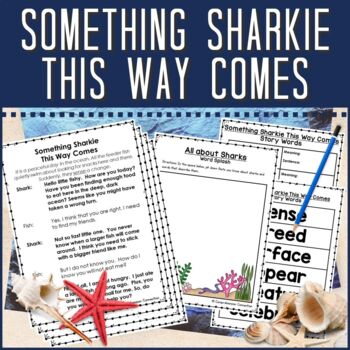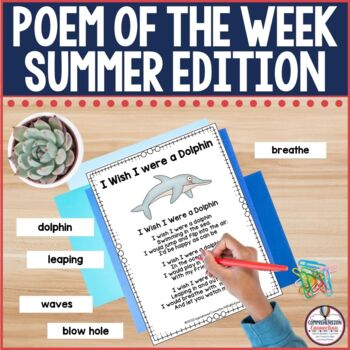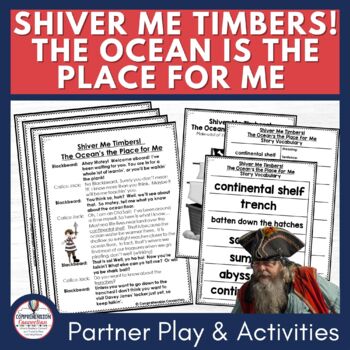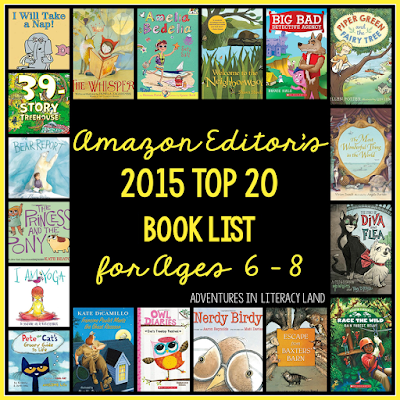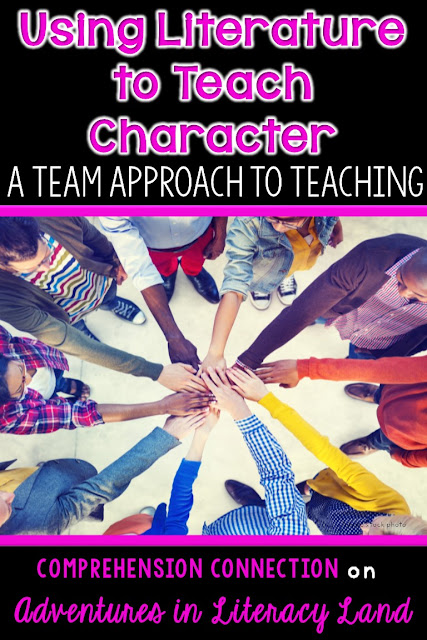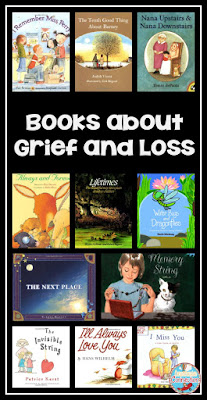Earlier this year I was intrigued by a blog post from Tammy over at Forever in First. She wrote about the book Moo! After checking it out myself, reading it to my students, watching my students read it over and over, I witnessed the power that one single word (plus punctuation) can have! And this only led to more books...
Adventures in Literacy Land: book recommendations
Showing posts with label book recommendations. Show all posts
Showing posts with label book recommendations. Show all posts

The Power of One Word
Earlier this year I was intrigued by a blog post from Tammy over at Forever in First. She wrote about the book Moo! After checking it out myself, reading it to my students, watching my students read it over and over, I witnessed the power that one single word (plus punctuation) can have! And this only led to more books...

Alphabet Books are for Everyone!
And you thought they were just for the younger crowd! Did you know that children in all grade levels can benefit from lessons learned in various alphabet books? There are so many different alphabet books that serve different purposes and can be used in many different ways.
Posted by
Andrea Crawford

Is Your Classroom Your Happy Place?
Hello everyone!
This is Laura from Where the Magic Happens Teaching Blog. Can you believe that I started school this week? Second grade is surely very different from 1st grade.
I spent the summer reading and learning the new set of standards, creating new materials, and visualizing what my new classroom was going to look like. I love the feeling of an empty classroom, the idea of a new beginning, and the potential and possibilities. More than anything, I kept on thinking (it was more like day dreaming), about a productive, brain friendly, and homey classroom.
Having an organized and quality classroom library makes me think that if nothing else, I am attempting to create the right conditions for reading by my students.
Think about it! A strong classroom library:
Two beach chairs, a lamp from the Goodwill, a cute rug from Walmart, some wooden letters and Voila! There you go!
One of the greatest suggestions that she gave me is to do a classroom library scavenger hunt. This, in order to teach my students to identify different series, authors, themes, and topics.
Oh! And also to help my students keep books and display materials orderly!
So I do different types of scavenger hunts:
Click HERE to download!
Click HERE to download!
Click HERE to download!
Or all of them!
I give the students one bookmark and they explore the classroom library, once they find a book that matches one item on their bookmark, they bring me the book and they get a punch! These bookmarks match my classroom library book bin labels.
I would love to hear and learn from all of you! How do you organize your classroom library? What routines and mini-lessons do you teach to help your students be successful? What things do you do to foster reading motivation??
I can honestly say that there are many happy places for me: my mom's house, my boys' arms, the beach, the mountains, my own classroom!
Until next time!
0
This is Laura from Where the Magic Happens Teaching Blog. Can you believe that I started school this week? Second grade is surely very different from 1st grade.
I spent the summer reading and learning the new set of standards, creating new materials, and visualizing what my new classroom was going to look like. I love the feeling of an empty classroom, the idea of a new beginning, and the potential and possibilities. More than anything, I kept on thinking (it was more like day dreaming), about a productive, brain friendly, and homey classroom.
It really starts with my classroom library. I have spent years (and tons of money and time) collecting the right books to reach ALL of my readers year after year. I truly believe that the concepts of classroom community and individuality begin with literature. It is my first goal, to show and provide my students with the opportunity to explore their own reading interests free from any constraints.
Or like my little G would say: "for the fun of it!"
I try to build momentum by not opening the complete library to my students on the first week of school. Instead, I open it gradually:
First the themes
Then the series
After this the nonfiction section
and so on...
Since we have such a large classroom library, our books are displayed all over the room in colorful tubs that I got from the Target dollar spot!
Having an organized and quality classroom library makes me think that if nothing else, I am attempting to create the right conditions for reading by my students.
Think about it! A strong classroom library:
- Supports your literacy instruction in and out of your classroom.
- Helps your students to learn about books and author's craft.
- It also provides a central location for classroom resources... hello shared research!!
- Serves as a place for students to talk about and interact with books
And you might think...
But how does she come up with the money to buy the books?
Well, let me just tell you: Scholastic points, yard sales, and The Goodwill are my friends! Last weekend for example, my local Goodwill had really great books for .50 a piece! It takes creativity and energy!!
Because my classroom is also really small this year, I had to become really creative too on finding a comfortable reading spot:
Two beach chairs, a lamp from the Goodwill, a cute rug from Walmart, some wooden letters and Voila! There you go!
Now, this is something to be really jelly about:
My school librarian is so fabulous and awesome. As this is my first year in 2nd grade, she has given me tons of suggestions about transitioning my students from easier picture books to a bit-more-challenging chapter books.One of the greatest suggestions that she gave me is to do a classroom library scavenger hunt. This, in order to teach my students to identify different series, authors, themes, and topics.
Oh! And also to help my students keep books and display materials orderly!
So I do different types of scavenger hunts:
Click HERE to download!
Click HERE to download!
Click HERE to download!
Click HERE to download!
Or all of them!
I give the students one bookmark and they explore the classroom library, once they find a book that matches one item on their bookmark, they bring me the book and they get a punch! These bookmarks match my classroom library book bin labels.
What is my goal with this?
I, more than anything, want to get my students motivated to read... and to read for fun. Throughout the year, I want to introduce them to authors, great series, themes, etc. Instead of giving them or leading them to a leveled book, I want them to be able to freely express about their reading choices and pursue them.
They each will have their own book box. With the book boxes there are a couple of whole group lessons that need to be addressed:
- Differences between picture books and chapter books
- Choosing "just right" books (blog post and anchor chart on this coming up next week)
- Keeping a balance in your book box
- How to return books
- Giving book recommendations
I would love to hear and learn from all of you! How do you organize your classroom library? What routines and mini-lessons do you teach to help your students be successful? What things do you do to foster reading motivation??
I can honestly say that there are many happy places for me: my mom's house, my boys' arms, the beach, the mountains, my own classroom!
Until next time!

Surf, Sand, and Fun for the End of the Year
Summer is not far off, and that means you are likely packing up your classroom and winding things down. Your mind is on vacation, and guess what. Your students' minds are on it too, so why not embrace it? Let's take an ocean themed classroom adventure with a staycation right in your classroom.
Best Books with an Ocean Theme
 Of all the books I chose to feature in today's post, there are a few that I truly just love. The first, Hello Ocean, has to be one of the most descriptive books available. If you are teaching figurative language, put this one on the list. The illustrations are just so real looking and help young readers who haven't been to the ocean actually feel like they have been. Pam Munoz Ryan selects just the right words to eloquently describe aspects of the ocean.
Of all the books I chose to feature in today's post, there are a few that I truly just love. The first, Hello Ocean, has to be one of the most descriptive books available. If you are teaching figurative language, put this one on the list. The illustrations are just so real looking and help young readers who haven't been to the ocean actually feel like they have been. Pam Munoz Ryan selects just the right words to eloquently describe aspects of the ocean. Riptide by Francis Weller is another favorite of mine. I am a dog lover, and our first dog was a Golden Retriever that looked just like Riptide. Caution though...this one has a really intense part. It is a true story, and your students will be on the edge of their seats with it. The reading level of it is mid third, and I used it in conjunction with a writing prompt focused on voice. The plot is very engaging, so if you're working on cause/effect relationships or plot development, this is a great choice.
Riptide by Francis Weller is another favorite of mine. I am a dog lover, and our first dog was a Golden Retriever that looked just like Riptide. Caution though...this one has a really intense part. It is a true story, and your students will be on the edge of their seats with it. The reading level of it is mid third, and I used it in conjunction with a writing prompt focused on voice. The plot is very engaging, so if you're working on cause/effect relationships or plot development, this is a great choice. Have you read the Scaredy Squirrel books? Scaredy Squirrel at the Beach is one of the cutest books. It would be a lot of fun for students to write their own Scaredy Squirrel stories or make a safety list for him or for other beach travelers. It is written with lots of voice/thought bubbles, so you might also follow that format with a cartoon strip.
Have you read the Scaredy Squirrel books? Scaredy Squirrel at the Beach is one of the cutest books. It would be a lot of fun for students to write their own Scaredy Squirrel stories or make a safety list for him or for other beach travelers. It is written with lots of voice/thought bubbles, so you might also follow that format with a cartoon strip.
Fun Activities to Check Out
Oh goodness, the activities are plentiful for an ocean theme. You can easily fill several weeks with writing extensions, science experiences and oodles of crafts. I found so many great activities on Pinterest, and this board will be growing. Whether you're ending the school year with an ocean theme, using it during summer school, or at the beginning of the year, you have lots of options to choose from.
Of the pins I added, I certainly have a few favorites. I just love watercolor artwork, and the two I pinned would be easy to make. My daughter made a few like these in an art camp one summer, and I still have them framed in her bathroom.
Along with art projects, there are many different science experiments you might try. The Ocean in a Bottle experiment was pinned quite a bit with different versions, and for our standards, creating a map of the ocean floor may make the terms a little easier to understand. I also love the paint swatch and flipbooks for showing how light travels through the ocean and impacts plant and animal life.
Finally, there are many writing options as well. The one I loved most came from 2nd Grade Shenanigans. I bet her kids loved the final products, and I am sure their parents kept them as a keepsake. Too fun!
Best Websites for Ocean Exploration
Take a virtual field trip to the beach with this website. Walk through all aspects of the ocean and learn lots of science concepts too.
Wow, this website would have been a tremendous asset a few months ago when I was working on oceanography with our fifth graders. Students can travel to the ocean floor to discover what is there and what the environment is like. Cool!

This last website is sponsored by PBS, so you know the footage and quality will be top notch. The Odyssey travels to the ocean floor with an underwater camera mounted on it. Again, students can get a true feel of what it's like on the ocean floor.
Before I sign off, I will share the links to a few of my Ocean themed resources. I will also share one of my ocean themed poems you can use to work on fluency with your students during your ocean themed staycation.

Now, don't forget to download your copy of the [Ocean Fun freebie]. Have a wonderful Memorial holiday next weekend, and just think...only a short time til Summer!!!


How to Use Top 20 Book Lists to Motivate and Excite Readers
What do you think qualifies a book for a
"Top 20" list?
Trendy Topic?
Eye catching cover?
Vivid Vocabulary?
A Plot like No Other?
Amazing facts?
Probably all of the above.
For today's post, we're going to explore those Top 20 lists a bit, see whether they are must haves, and how they can add to the learning in your classroom.
Have you wondered where you find Top 20 Lists and who makes them? Does that make a difference? You betcha! After all, if the reader is a child, it might be wise to get a child's point of view I'd think. If you think about Trip Advisor or other sites that do rankings, they typically have some criteria for their decisions and expertise in the field. Some top 20 lists may be done by sales while others may be judged by librarians or site managers. Regardless of how the lists are formed, they do highlight new titles for us. They are great ways to learn about what's new in children's literature and if you purchase them, it gives you a chance to do a little "market research" for yourself to see if they really measure up. Not willing to let loose of the cash? Maybe pull them from the library first to see for yourself.
Before I move on with this post, I feel like I should share that the idea for this post came when I visited Amazon this last weekend. I discovered the Top 20 lists in the children's book section on the site. Well, I am a book hound, so I had to check the lists out. You know there might be a title that I DON'T have (gasp!), so I went to take a peak, and here's what I found. This is the book list for ages 6-8. At first, I thought it was a list from the New York Times, but then I found it was the Amazon Editor's list. It does not say what the selection criteria was, so I'm not sure if it's based on sales, choices the editors liked, or if there was an evaluation process. Even though I'm not sure how the books were selected, I did notice common themes..animals, adventure, and make-believe. I also noticed a few favorite authors and book series including Pete the Cat, Amelia Bedelia,and Francine Poulet. Mo Willems also made the list, but there are also lots of unique looking books too. I am very curious about Nerdy Birdy, The Whisperer, and Escape from Baxter's Barn. Out of this 20 book list, only five or six were familiar to me, and I love that because now I have new options to look for in the coming months.
So, how can the enthusiasm we get when we see or hear about new titles translate into classroom enthusiasm? Ultimately, that is the reason for the book lists. The goal is to build excitement about the books and more importantly, getting the books into the hands of kids.
Before I move on with this post, I feel like I should share that the idea for this post came when I visited Amazon this last weekend. I discovered the Top 20 lists in the children's book section on the site. Well, I am a book hound, so I had to check the lists out. You know there might be a title that I DON'T have (gasp!), so I went to take a peak, and here's what I found. This is the book list for ages 6-8. At first, I thought it was a list from the New York Times, but then I found it was the Amazon Editor's list. It does not say what the selection criteria was, so I'm not sure if it's based on sales, choices the editors liked, or if there was an evaluation process. Even though I'm not sure how the books were selected, I did notice common themes..animals, adventure, and make-believe. I also noticed a few favorite authors and book series including Pete the Cat, Amelia Bedelia,and Francine Poulet. Mo Willems also made the list, but there are also lots of unique looking books too. I am very curious about Nerdy Birdy, The Whisperer, and Escape from Baxter's Barn. Out of this 20 book list, only five or six were familiar to me, and I love that because now I have new options to look for in the coming months.
So, how can the enthusiasm we get when we see or hear about new titles translate into classroom enthusiasm? Ultimately, that is the reason for the book lists. The goal is to build excitement about the books and more importantly, getting the books into the hands of kids.
TOP 20 IDEAS FOR THE CLASSROOM
Looking through Amazon's Top 20 list got my teaching wheels going. I had flashbacks to Lettermen's Top 10 Lists. Remember those?? We found them interesting and funny. I hope as you scan through these ideas, your teaching wheels get going too.
Create Room __'s Top 20 Best Books for 2015
Take your class into the library for a Top 20 analysis session. Prior to the visit, develop a selection criteria with the group. You might set a page range, publishing year (of course), characteristics the students agree upon, and time limit prior to going, and once in the library, you'd want to have forms available for the students complete in order to keep them accountable. You might pair your students to allow for deeper discussion and comparison. You could have each pair of students come up with two books they'd put on the list which would ideally end up being around 20 books total. You could gather up the books and allow the students to "visit them" throughout the following week and then rank them in the order they feel is best.
Develop Top 20 Book Lists by Genre
Develop Top 20 Book Lists by Genre
After you've developed overall winner lists as a group, you might move on to genre lists. Kids have reading preferences, so tapping into those can lead to better book selection later on. In fact, I'd divide into groups based on the books that the kids prefer. Again, you'd want to establish the selection criteria and how the researching will be done. (Do you allow kids to search the internet? In the library? or do it by polls?) Once the time limit is up, then it's time to narrow by analyzing those in the first "selection round". You might even compare this experience to the NBA draft. :-) Secretly though, you're developing a reader's eye for book selection and providing kids with a mental list of what they want to read next.
Real Readers Need Personal Lists
After experiencing these first two options, you can then focus on reader plans. Real readers need ongoing lists of what to read next. If you remember, we've had a few posts about Donalyn Miller's 50 Book Challenge, and I think Top 20 Lists feed right into it. Your kids can keep and revise their Top 20 list all year long. Imagine how fun it'd be to compare the list at the beginning of the year and at the end of the year. My guess is that it will change as the year goes, don't you think?
I read recently as I was researching and thinking about a blog post I wrote about deep thinking that classifying and categorizing information is one great way to work on deep thinking. Throughout the list making process, your kids will be using the following skills:
I read recently as I was researching and thinking about a blog post I wrote about deep thinking that classifying and categorizing information is one great way to work on deep thinking. Throughout the list making process, your kids will be using the following skills:
- comparing across texts specific features you've agreed upon.
- analyzing the text features of the books including plot and character development, vocabulary usage, and creativity.
- observing through the writer's eye which may lead to improved writing skill.
- learning about new titles and authors
- using library tools to look for their books

What skills would you add to this list? How would you change up the idea or use Top 20 lists? (please share in the comments).

Using Literature to address Character: A Team Approach to Teaching
Are you ready for your next PLC meeting? You know the one where everyone sits around the table wondering how to help the strugglers over the testing hurdle and how to ease tensions between your strong personalities. After reading through this post, I hope that PLC meeting will give you a chance to catch your counselor and tech specialist so that you can put your heads together and build a great cross-curricular instructional plan. Last year, I reached out to our guidance counselor and technology specialist, and what we came up with was a smashing success. I want to share it with you in case you'd like to try it out too. Here's how it worked...
 Another great topic for this time of year is friendship. This book collection is all about building relationships. You can share books like Wilfred Gordan McDonald Partridge to demonstrate how we can support and help the elderly. This book is just wonderful for character development, sequencing events, and theme. Students can write about their best older friend, and once again, we can bring in guidance as we talk about aging and responsibility. You might have students interview an "older friend" and create a movie with Animato in your lab.
Another great topic for this time of year is friendship. This book collection is all about building relationships. You can share books like Wilfred Gordan McDonald Partridge to demonstrate how we can support and help the elderly. This book is just wonderful for character development, sequencing events, and theme. Students can write about their best older friend, and once again, we can bring in guidance as we talk about aging and responsibility. You might have students interview an "older friend" and create a movie with Animato in your lab.
 The last topic I thought I'd share is the topic I started with, Bullying. Believe it or not, there are books at all age levels on this topic. For the primary grades, I love Swimmy by Leo Lionni, Goggles by Ezra Jack Keats, Stand Tall Molly Lou Melon and The Recess Queen. In upper elementary, you could pull many of Patricia Polacco's books, Enemy Pie, or Tough Boris. You can also explore this theme with chapter books with The Hundred Dresses, Esperanza Rising, Wonder, and Maniac Magee. There are so many options. I gave you a few thoughts early on about how to involve your teammates. [Here] is the link to the unit for Bully if you're interested. You might modify these ideas for primary grades to be about including others and friendship.
The last topic I thought I'd share is the topic I started with, Bullying. Believe it or not, there are books at all age levels on this topic. For the primary grades, I love Swimmy by Leo Lionni, Goggles by Ezra Jack Keats, Stand Tall Molly Lou Melon and The Recess Queen. In upper elementary, you could pull many of Patricia Polacco's books, Enemy Pie, or Tough Boris. You can also explore this theme with chapter books with The Hundred Dresses, Esperanza Rising, Wonder, and Maniac Magee. There are so many options. I gave you a few thoughts early on about how to involve your teammates. [Here] is the link to the unit for Bully if you're interested. You might modify these ideas for primary grades to be about including others and friendship.

5
One of my favorite authors is Patricia Polacco, and last year, as I was developing materials to use with her book, Bully, I decided I wanted to involve our guidance counselor and technology specialist in some of the lessons I had planned. It just happened to be February when I was using this book, so the timing was just right. Here's an outline of how it worked.
- Our counselor addressed bullying with the fifth grade groups with classroom guidance lessons.
- This book also happened to have cyber bullying themes, so I involved our technology specialist by asking her to come in and team with me with a group discussion on internet safety.
- In the meantime, we wrote about how to handle situations when someone bullies you, and I taught comprehension skills with this book as the mentor text. My students were quite pleased to have their writing pieces highlighted in the classroom guidance lessons.
- Finally, the three of us working together demonstrated to the students that teamwork is important in the classroom AND in the workplace.
Using Literature to Ease Anxiety
Around this time of year, we are analyzing our data to see what interventions need to happen for those not progressing as they should. Anxiety begins to build for teachers and for students since we're talking about progress more. Luckily for us, we can reach for wonderful books to model perseverance, determination, and managing our worries. Salt in His Shoes, Wilma Unlimited, Wilma Jean, Worry Machine, and Wemberly Worried are just a few favorites of mine. The books can get you started with discussions (in guidance and during ELA block), but you might use Today's Meet to bring in technology too. Your tech specialist and guidance counselor will also be deeply involved in helping your group prepare for testing too, so it is certainly good to be prepared so that your students are confident and ready. With Salt in His Shoes, you can talk about things students find challenging. Setting measurable goals can help your students have a sense of accomplishment which also builds confidence.
Using Literature to Build Relationships
 Another great topic for this time of year is friendship. This book collection is all about building relationships. You can share books like Wilfred Gordan McDonald Partridge to demonstrate how we can support and help the elderly. This book is just wonderful for character development, sequencing events, and theme. Students can write about their best older friend, and once again, we can bring in guidance as we talk about aging and responsibility. You might have students interview an "older friend" and create a movie with Animato in your lab.
Another great topic for this time of year is friendship. This book collection is all about building relationships. You can share books like Wilfred Gordan McDonald Partridge to demonstrate how we can support and help the elderly. This book is just wonderful for character development, sequencing events, and theme. Students can write about their best older friend, and once again, we can bring in guidance as we talk about aging and responsibility. You might have students interview an "older friend" and create a movie with Animato in your lab.
Last year, I used the book, Owen and Mzee, to talk about friendship. We researched tsunamis and the countries around the Indian ocean where Owen and Mzee were rescued. I was lucky to find several links to articles and movie clips about them too. Your guidance counselor might talk about uncommon friendships and how important to reach out to those who need a friend. Have you read, Each Kindness by Jacqueline Woodson? Grab your tissues. You will need them. Sometimes challenging books can make us think too. [This set] in my store features Each Kindness, and after sharing it with my students, we created a class "Welcome Book". Having students introduce themselves is a great way to learn trivial things about them that you might not learn otherwise.
Using Literature to Deal with Grief and Loss
Sadly, at some point in our career, we are faced with helping a child through a loss. It might be the family pet, a grandparent, or even worse, a parent or sibling. For my own children, the first death that hit them hard was the loss of our family dog and then, a month later, my father passed. It really caught us all by surprise, and with that experience, I learned that we need to be prepared and we need to prepare kids. This is challenging for everyone, and I am certainly not recommending a month long set of lessons. However, I would try to gather resources for when they are needed. Having a basket of books put together and/or a book list that you can share will help you feel prepared. If you wish to share a book or two, I would recommend Memory String by Eve Bunting and The Tenth Good Thing about Barney by Judith Viorst. By gently touching on the topic, we can help provide a little schema for our students that might help when the time comes. (okay...enough of this topic).
Using Literature to Address Bullying
 The last topic I thought I'd share is the topic I started with, Bullying. Believe it or not, there are books at all age levels on this topic. For the primary grades, I love Swimmy by Leo Lionni, Goggles by Ezra Jack Keats, Stand Tall Molly Lou Melon and The Recess Queen. In upper elementary, you could pull many of Patricia Polacco's books, Enemy Pie, or Tough Boris. You can also explore this theme with chapter books with The Hundred Dresses, Esperanza Rising, Wonder, and Maniac Magee. There are so many options. I gave you a few thoughts early on about how to involve your teammates. [Here] is the link to the unit for Bully if you're interested. You might modify these ideas for primary grades to be about including others and friendship.
The last topic I thought I'd share is the topic I started with, Bullying. Believe it or not, there are books at all age levels on this topic. For the primary grades, I love Swimmy by Leo Lionni, Goggles by Ezra Jack Keats, Stand Tall Molly Lou Melon and The Recess Queen. In upper elementary, you could pull many of Patricia Polacco's books, Enemy Pie, or Tough Boris. You can also explore this theme with chapter books with The Hundred Dresses, Esperanza Rising, Wonder, and Maniac Magee. There are so many options. I gave you a few thoughts early on about how to involve your teammates. [Here] is the link to the unit for Bully if you're interested. You might modify these ideas for primary grades to be about including others and friendship.
How do you work with your colleagues? Have you thought about cross-curricular units? Maybe you pair with a primary teacher for reading buddies? You might choose books with one of these themes each month to work on school climate, or maybe pair your classes for a group project. There are certainly lots of options if you put your heads together. I think it's a great way to use your PLC time to improve school climate, don't you?
Until next time, happy reading and see you next month, literacy fans. Now let's collaborate!

Subscribe to:
Posts (Atom)


























